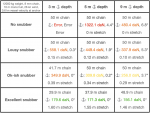roaringgirl
Well-known member
The thread on here about using carabiners for mooring made me think about the forces involved. I use a soft shackle to attach the snubber to the chain. It is made of 4mm dyneema with a breaking strain of 15kN. The way the soft shackle is made, there are 4 strands taking the strain so 60kN.
Starting with F = ma
F = 60,000N
m = 12,000 kg (for my boat)
So the acceleration (deceleration) that would snap the soft shackle is 5ms^-2, which equates to 9kts/sec.
Sitting at anchor I sometimes see 2kts in big gusts or surges, and I estimate that the anchor decelerates us back to 0 in about a second.
The carabiner on my climbing harness is rated to 7kN. Running through the same numbers gives a breaking deceleration of 0.6ms^-2 or 1.1kts/s...
Starting with F = ma
F = 60,000N
m = 12,000 kg (for my boat)
So the acceleration (deceleration) that would snap the soft shackle is 5ms^-2, which equates to 9kts/sec.
Sitting at anchor I sometimes see 2kts in big gusts or surges, and I estimate that the anchor decelerates us back to 0 in about a second.
The carabiner on my climbing harness is rated to 7kN. Running through the same numbers gives a breaking deceleration of 0.6ms^-2 or 1.1kts/s...

